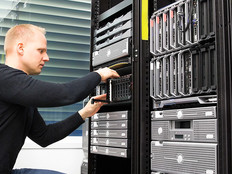Converged Infrastructure Boosts Data Center Security via Increased Visibility
Converged infrastructure can help organizations cut costs, increase operational efficiency and free up IT staff members to focus on other technology tasks. On top of all of that, it can also improve cybersecurity.
Converged infrastructure — deploying compute, networking and storage components in a single platform — helps break down silos inside a data center, and that brings increased security.
SIGN UP: Get more news from the BizTech newsletter in your inbox every two weeks!
Simplified Infrastructure Leads to Enhanced Protection
“We need to actually protect everything,” says Vito Ferrante, EMC team lead at CDW, in a CDW webinar sponsored by Dell EMC. “And that’s an ongoing process. It never ends.”
Organizations need to protect their data centers — and data — from a variety of vulnerabilities, he said, including system failures, drive failures, data center outages or other disasters.
“Converged infrastructure also solves that issue because when the proper solution is purchased, industry-leading protection is part of the DNA of the system,” Ferrante says.
Eric Sheppard, IDC’s research director of enterprise storage and converged systems, notes that converged infrastructure allows forward-looking IT teams to “think about the transformation of the teams and to move away from a set of teams that are siloed” among networking, storage, virtualization, servers and so forth.
Convergence “creates a foundation that is easily understandable, that is visible, that is holistic, and, as such, you don’t have problems as frequently as you might have in a system filled to the brim with silos.”
In short, Sheppard says, by moving to converged infrastructure, companies can gain better understanding of and greater visibility into their IT environments. That “creates a starting point for reduced risk” and fewer surprises for IT staff.
“It’s hard to protect yourself if you can’t fully understand your foundation, your infrastructure,” he says.
Patching Systems and Protecting Data
Converged infrastructure also helps organizations with patch rollouts because it gives them a “better shot” at understanding their IT inventory when data centers are streamlined, Sheppard says.
If there is risk associated with specific versions of data center systems or software, he adds, greater visibility into data center environments will allow IT managers to better assess their risks. They will then be able to check if their firmware or software is out of date or vulnerable to industrywide threats. Converged infrastructure vendors will help companies make sure those patches and updates are done, Sheppard says.
Ferrante points out that data protection is a key concern for everyone and that all Dell Virtual Computing Environment products are protected by Dell EMC’s data protection suite.
That product portfolio, he notes, couples hardware and software “to ensure your data is safe.” Dell EMC also uses a variety of products to protect customers’ data, Ferrante says, including Avamar, Data Domain and Networker, among others.
“Just like the VCE portfolio, there is no single silver bullet to solve all data protection concerns,” he says.
For more info, check out, “How Your Business Can Benefit from Converged Infrastructure.” And for more on the benefits of converged infrastructure, check out the CDW webinar sponsored by Dell EMC.









